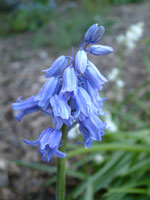 Spring-flowering bulbs such as bluebells, daffodils and grape hyacinth have died back now and the nutrients in the leaves have returned to the bulb. This is a good time, then, for dividing the clumps to multiply stock. It will also renew vigour, ensuring plenty of nectar in spring for butterflies, honey bees and mason bees. Snakeshead fritillaries need to be divided and replanted every 4 years.
Spring-flowering bulbs such as bluebells, daffodils and grape hyacinth have died back now and the nutrients in the leaves have returned to the bulb. This is a good time, then, for dividing the clumps to multiply stock. It will also renew vigour, ensuring plenty of nectar in spring for butterflies, honey bees and mason bees. Snakeshead fritillaries need to be divided and replanted every 4 years. Lavender is a popular summer-flowering aromatic shrub and a great addition to the wildlife-friendly garden. The flowers are particularly attractive to butterflies such as meadow browns and late broods of whites. The nectar is also a centre of attention for bees and other insects. The seeds are enjoyed by goldfinches and the leaves are popular with froghopper larvae.
Watch out for blue tits congregating in groups, including the smaller and duller-coloured youngsters. In the pond tadpoles are undergoing the final stages of their dramatic transformation into adults.
 Spring-flowering bulbs such as bluebells, daffodils and grape hyacinth have died back now and the nutrients in the leaves have returned to the bulb. This is a good time, then, for dividing the clumps to multiply stock. It will also renew vigour, ensuring plenty of nectar in spring for butterflies, honey bees and mason bees. Snakeshead fritillaries need to be divided and replanted every 4 years.
Spring-flowering bulbs such as bluebells, daffodils and grape hyacinth have died back now and the nutrients in the leaves have returned to the bulb. This is a good time, then, for dividing the clumps to multiply stock. It will also renew vigour, ensuring plenty of nectar in spring for butterflies, honey bees and mason bees. Snakeshead fritillaries need to be divided and replanted every 4 years. 


0 Comments:
Post a Comment
<< Home